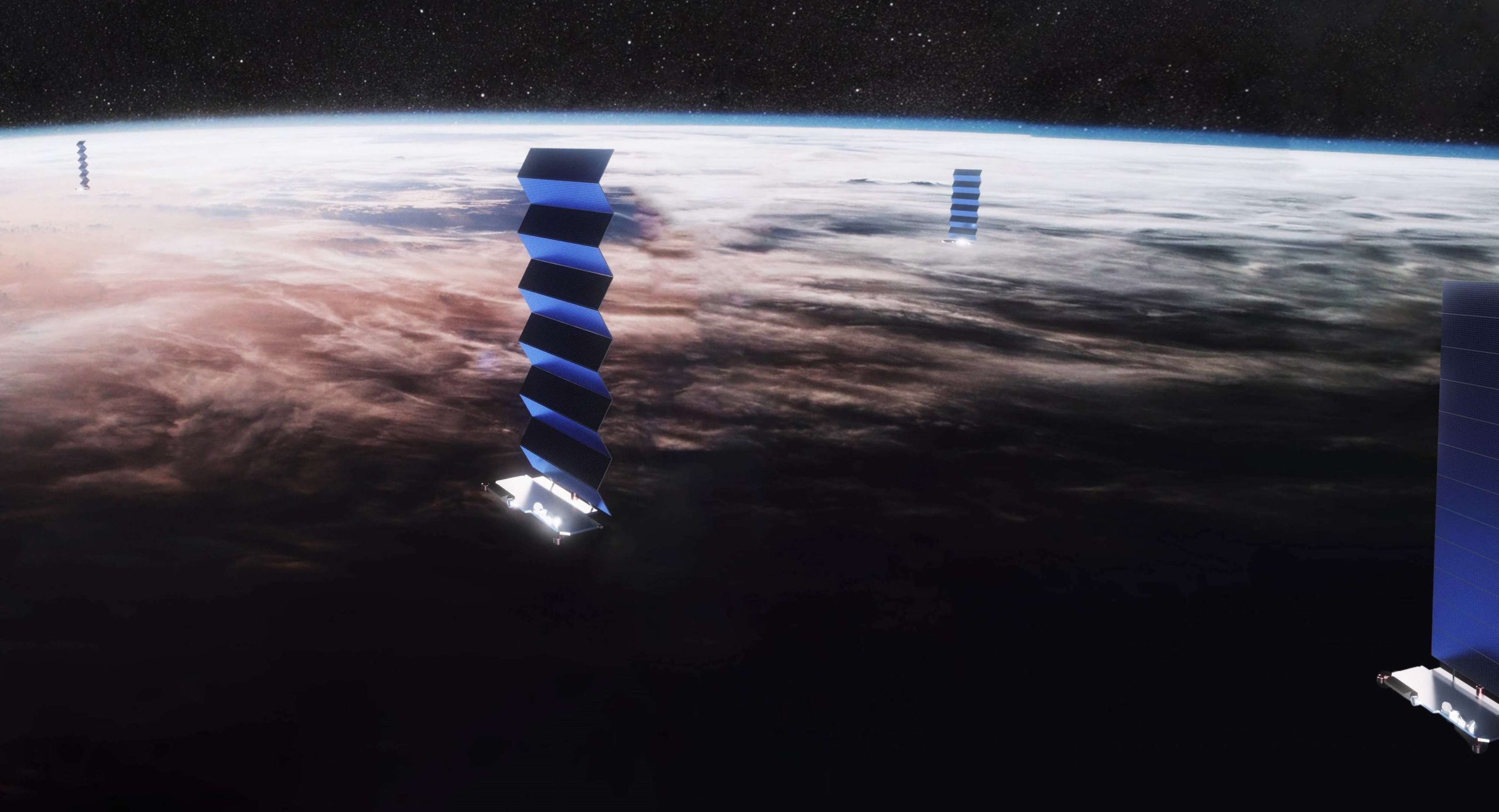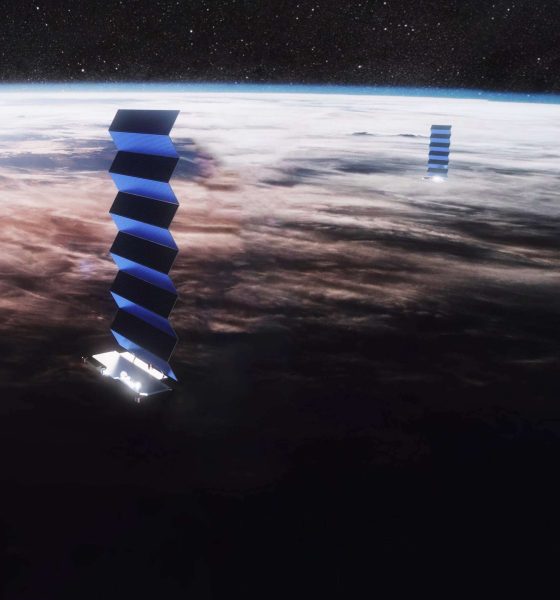

News
SpaceX’s Starlink satellites spark fights between astronomy, spaceflight fans
Just a handful of hours after SpaceX successfully placed all 60 of its first Starlink v0.9 satellites in orbit, ground observers began capturing and sharing spectacular nighttime views of the spacecraft. Soon after, fans and practitioners of astronomy and spaceflight began bickering.
The topic of concern: light pollution, not from lights on the ground but from sunlight-reflecting satellites in orbit. Immediately after launch, the ‘train’ of 60 Starlink satellites were undeniably spectacular, easily visible to the eye and as bright or brighter than the brightest stars in the sky. For the most part, reactions seemed to lean more towards awe than concern, but it didn’t take long for people to begin extrapolating from 60 satellites to Starlink’s peak of ~11,900 (an increase of 200X), and some responses began to paint SpaceX’s constellation in a more negative light.
Fans, communicators, and practitioners of astronomy quickly grew into the loudest voice in the room, as fans of SpaceX and Elon Musk started to engage, ultimately making it clear that low Earth orbit (LEO) megaconstellations could soon become a highly controversial topic for unexpected reasons. As is typical of humans in the age of social media, the gentlest hint of controversy and criticism swelled into stone-throwing between two crystallized sides unwilling to breathe and engage in civil debate.
Meanwhile, barely 24-48 hours had elapsed since the first Starlink satellite reached orbit – not their final orbit (550 km) but an insertion orbit at ~450 km. Almost immediately, serious observers noted that the Starlink satellites were rapidly spreading out and dimming as they got to work raising their orbits with onboard ion thrusters. Situated in an urban area, Teslarati photographer Tom Cross described the Starlink ‘train’ as “way too faint to capture” on the evening of May 25th, although they were still subtly visible to the naked eye.
From a practical perspective, it should come as little to no surprise that Starlink satellites are visible – even highly visible – from the ground, particularly in areas with minimal light pollution. SpaceX’s flat-panel design and the location of their antennas means that each satellite will have a metallic, shiny surface constantly facing towards the ground, perfect for reflecting sunlight. Additionally, every satellite has a fairly large solar array, likely measuring about 3m by 12m (10ft by 40 ft). Combined, the 60 satellites have a collective solar array area of more than 2000 square meters (21,500 ft^2), nearly the same size as the International Space Station’s football field-sized arrays.

Here’s a 30 second long exposure of #starlink satellites marching across the sky. I saw them, framed this up, and started it as quickly as I could so there is zero creativity or planning here but I GOT THEM! Aghhhh. @elonmusk — you seen your satellites overhead yet? pic.twitter.com/91KzFKOUq1— ?Trevor Mahlmann (@TrevorMahlmann) May 25, 2019
An astronomical disruption?
However, the visibility of SpaceX’s Starlink satellites for laypeople was never the most contentious concern or a leader of vitriolic responses. Rather, even if the ~12,000 proposed Starlink satellites are minimally visible to the naked eye, they will almost certainly still appear in the sort of long-exposure images used by astronomers to catalog, track, and better understand the universe. This is a reasonable concern and one that should come as little to no surprise, given that astronomy already deals with the thousands of operational and defunct satellites, rocket upper stages, and pieces of large space debris already in Earth orbit.
The problem with giant LEO constellations is that satellites in LEO can appear far brighter and far larger than the traditional geostationary satellites used to provide communications services. This is a critical benefit for the spacecraft, as geostationary distances (~36,000 km, 22,000 mi) create major latency (lag) problems for communications networks.
Will Starlink (alongside other constellations from Telesat, OneWeb, and LeoSat) destroy the night sky as we know it, ruining the perfectly untouched cosmos for the rest of eternity? Will Starlink immediately create a global utopia by affordably connecting every single human on Earth to the internet, all while being completely invisible and undetectable from the ground? No, no, no, and no. As with 99.99% of things, the reality will fall somewhere in the middle and its consequences and benefits will be far more grey than black and white.
Update: Elon Musk addresses the controversy over Starlink light pollution
As more levelheaded spaceflight fans and astronomers thankfully point out, we need to wait weeks – if not months or even years – to actually understand the potential impact LEO mega-constellations might have on science and society. It would likely be beneficial for SpaceX – thus far silent – to open a dialogue with those concerned about those potential impacts. It would also serve astronomy well to find ways to cope with space-based infrastructure meant to eventually benefit tens of millions to billions of people, ranging from astronomers themselves to underprivileged members of developing societies. To accept tradeoffs and make compromises is to be human.

Check out Teslarati’s Marketplace! We offer Tesla accessories, including for the Tesla Cybertruck and Tesla Model 3.

News
Tesla FSD fleet is nearing 7 billion total miles, including 2.5 billion city miles
As can be seen on Tesla’s official FSD webpage, vehicles equipped with the system have now navigated over 6.99 billion miles.

Tesla’s Full Self-Driving (Supervised) fleet is closing in on almost 7 billion total miles driven, as per data posted by the company on its official FSD webpage.
These figures hint at the massive scale of data fueling Tesla’s rapid FSD improvements, which have been quite notable as of late.
FSD mileage milestones
As can be seen on Tesla’s official FSD webpage, vehicles equipped with the system have now navigated over 6.99 billion miles. Tesla owner and avid FSD tester Whole Mars Catalog also shared a screenshot indicating that from the nearly 7 billion miles traveled by the FSD fleet, more than 2.5 billion miles were driven inside cities.
City miles are particularly valuable for complex urban scenarios like unprotected turns, pedestrian interactions, and traffic lights. This is also the difference-maker for FSD, as only complex solutions, such as Waymo’s self-driving taxis, operate similarly on inner-city streets. And even then, incidents such as the San Francisco blackouts have proven challenging for sensor-rich vehicles like Waymos.
Tesla’s data edge
Tesla has a number of advantages in the autonomous vehicle sector, one of which is the size of its fleet and the number of vehicles training FSD on real-world roads. Tesla’s nearly 7 billion FSD miles then allow the company to roll out updates that make its vehicles behave like they are being driven by experienced drivers, even if they are operating on their own.
So notable are Tesla’s improvements to FSD that NVIDIA Director of Robotics Jim Fan, after experiencing FSD v14, noted that the system is the first AI that passes what he described as a “Physical Turing Test.”
“Despite knowing exactly how robot learning works, I still find it magical watching the steering wheel turn by itself. First it feels surreal, next it becomes routine. Then, like the smartphone, taking it away actively hurts. This is how humanity gets rewired and glued to god-like technologies,” Fan wrote in a post on X.
News
Tesla starts showing how FSD will change lives in Europe
Local officials tested the system on narrow country roads and were impressed by FSD’s smooth, human-like driving, with some calling the service a game-changer for everyday life in areas that are far from urban centers.

Tesla has launched Europe’s first public shuttle service using Full Self-Driving (Supervised) in the rural Eifelkreis Bitburg-Prüm region of Germany, demonstrating how the technology can restore independence and mobility for people who struggle with limited transport options.
Local officials tested the system on narrow country roads and were impressed by FSD’s smooth, human-like driving, with some calling the service a game-changer for everyday life in areas that are far from urban centers.
Officials see real impact on rural residents
Arzfeld Mayor Johannes Kuhl and District Administrator Andreas Kruppert personally tested the Tesla shuttle service. This allowed them to see just how well FSD navigated winding lanes and rural roads confidently. Kruppert said, “Autonomous driving sounds like science fiction to many, but we simply see here that it works totally well in rural regions too.” Kuhl, for his part, also noted that FSD “feels like a very experienced driver.”
The pilot complements the area’s “Citizen Bus” program, which provides on-demand rides for elderly residents who can no longer drive themselves. Tesla Europe shared a video of a demonstration of the service, highlighting how FSD gives people their freedom back, even in places where public transport is not as prevalent.
What the Ministry for Economic Affairs and Transport says
Rhineland-Palatinate’s Minister Daniela Schmitt supported the project, praising the collaboration that made this “first of its kind in Europe” possible. As per the ministry, the rural rollout for the service shows FSD’s potential beyond major cities, and it delivers tangible benefits like grocery runs, doctor visits, and social connections for isolated residents.
“Reliable and flexible mobility is especially vital in rural areas. With the launch of a shuttle service using self-driving vehicles (FSD supervised) by Tesla in the Eifelkreis Bitburg-Prüm, an innovative pilot project is now getting underway that complements local community bus services. It is the first project of its kind in Europe.
“The result is a real gain for rural mobility: greater accessibility, more flexibility and tangible benefits for everyday life. A strong signal for innovation, cooperation and future-oriented mobility beyond urban centers,” the ministry wrote in a LinkedIn post.
News
Tesla China quietly posts Robotaxi-related job listing
Tesla China is currently seeking a Low Voltage Electrical Engineer to work on circuit board design for the company’s autonomous vehicles.

Tesla has posted a new job listing in Shanghai explicitly tied to its Robotaxi program, fueling speculation that the company is preparing to launch its dedicated autonomous ride-hailing service in China.
As noted in the listing, Tesla China is currently seeking a Low Voltage Electrical Engineer to work on circuit board design for the company’s autonomous vehicles.
Robotaxi-specific role
The listing, which was shared on social media platform X by industry watcher @tslaming, suggested that Tesla China is looking to fill the role urgently. The job listing itself specifically mentions that the person hired for the role will be working on the Low Voltage Hardware team, which would design the circuit boards that would serve as the nervous system of the Robotaxi.
Key tasks for the role, as indicated in the job listing, include collaboration with PCB layout, firmware, mechanical, program management, and validation teams, among other responsibilities. The role is based in Shanghai.
China Robotaxi launch
China represents a massive potential market for robotaxis, with its dense urban centers and supportive policies in select cities. Tesla has limited permission to roll out FSD in the country, though despite this, its vehicles have been hailed as among the best in the market when it comes to autonomous features. So far, at least, it appears that China supports Tesla’s FSD and Robotaxi rollout.
This was hinted at in November, when Tesla brought the Cybercab to the 8th China International Import Expo (CIIE) in Shanghai, marking the first time that the autonomous two-seater was brought to the Asia-Pacific region. The vehicle, despite not having a release date in China, received a significant amount of interest among the event’s attendees.








